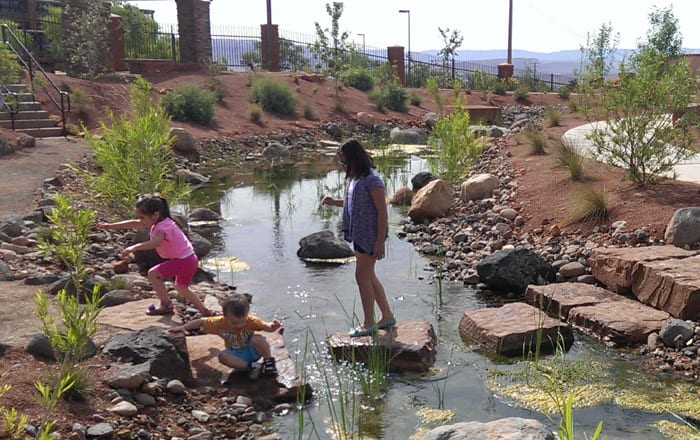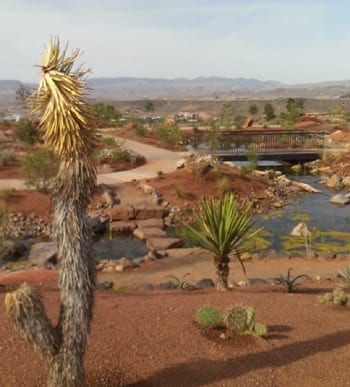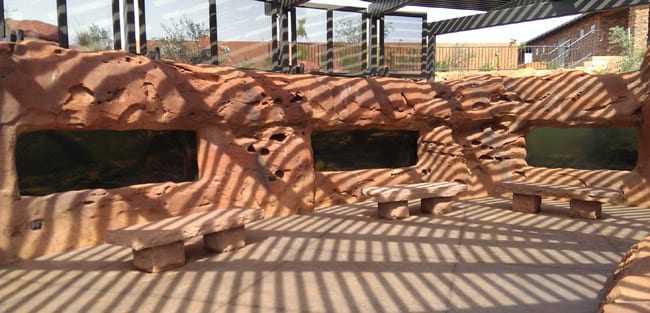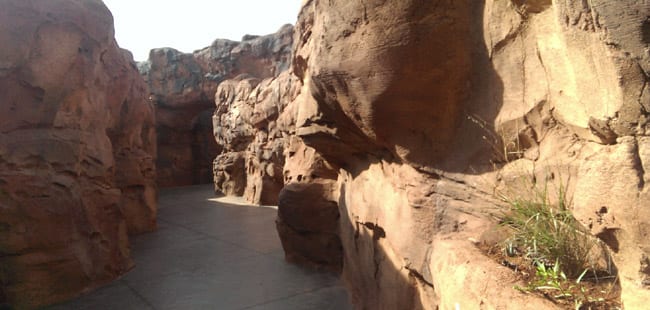Written by Marcos Camargo
On Wednesday, May 20, the Washington County Water Conservancy District hosted the opening of the newly built Red Hills Desert Garden. A monumental project, construction of the garden began in 2011 as a joint effort between WCWCD, the Virgin River Program, St. George City, and private donors. Red Hills Desert Garden features an artificial stream, a fish viewing area, and an artificial slot canyon. The garden is landscaped entirely with native plants, and the stream is stocked with native fish. According to an October 2011 press release, “the garden project is expected to educate local residents as well as visitors concerning: effective water conservation methods, water-wise landscaping ideas, endangered fish species inhabiting our local rivers, and the endangered desert tortoise.”
The stream runs through the center of the garden. Several footbridges and stepping-stones allow visitors to get a view directly over the water. Karry Rathje, public information manager for WCWCD, said the water that supplies the stream is pumped from Skyline Pond and filters through the gardens.
“It goes into the city’s secondary water system and is used to water parks, golf courses, and cemeteries,” Rathje said, “so it’s not really using any water.”
In addition to the native fish, the stream supports several species of water plants such as cattails and coyote willows. These, combined with the placement of logs and rocks, give the stream a natural look.
Corey Cram, associate general manager of the WCWCD, said they tried to landscape with riparian species at the edge of the stream and then move into more desert upland species further from the bank.
“People are attracted to water,” Cram said, “so it makes a great central feature.”
Cram said he hopes the gardens will show local residents the beauty of water-efficient native landscaping. In order to do this, every plant species in the garden will be labeled with a name and a QR code for smartphone scanning. This way the public can identify plants that they want to use in their own gardens and find information about each one.
“The whole purpose here is to teach water conservation and landscaping principles,” said Cram when asked about the goals behind building Red Hills Desert Garden. “We had the first water conservation plan in the state, and we have exceeded the amount of conservation the rest of the state has achieved. We believe we’re leading the way in conservation.”
Cram said the garden will offer amazing opportunities to educate the public on water conservation in areas such as xeriscape gardening, which is landscaping that eliminates or significantly reduces the need for supplemental irrigation.
Rathje specifically cited the WCWCD’s achievements in reducing water consumption in Washington County.
“Residential water use has decreased 26 percent from 2000 to 2010,” said Rathje, “so we’ve seen significant savings. The governor’s goal was to decrease water use 25 percent by 2025, and we’ve already exceeded that.”
Rathje also brought up the fact that Washington County is the first in the state of Utah to build a desert conservation garden.
Another prominent feature of Red Hills Desert Garden is the fish viewing area, a large concrete embankment that surrounds a below-ground pavilion fitted with viewing windows, much like a natural aquarium.
The stream has been stocked with three native fish species: speckled dace, desert sucker, and Virgin River chub, a federally listed endangered species. Steve Meismer, fish biologist and local coordinator for the Virgin River Program, was onsite to answer questions about the fish brought into the stream.
Meismer said that there has already been reproduction observed among the speckled dace since the stream was first stocked three weeks ago. The gardens, however, will not be used for breeding fish to take elsewhere.
“We don’t want to be moving fish around,” said Meismer. “That was one of the things we thought about… we talked with the Division of Wildlife and the Department of Agriculture, and because people are able to come in here whenever they want, somebody could drop a fish in here, and we could [unknowingly] transfer it to an outside location. Whatever is reproduced in here will stay in here.”
“Bringing in these fish is an educational opportunity,” Meismer continued. “What this allows us to do is bring the fish to the people. I don’t know how may times I have had people come up to me and say, ‘There are fish in the Virgin River?’ This gives people the opportunity to come see them.”
Meismer said that while aquariums are great, the stream at the garden offers a unique learning experience.
“Here the fish are in a stream where they have to deal with flowing water and find their own food, so it’s a really neat opportunity for education,” he said. “We anticipate bringing students down here and showing them the fish. This stream is green and it’s murky, but that’s what the fish have to deal with. The kids don’t see that when you show it to them in an aquarium or on a projected screen.”
Meismer said he believes that reducing water consumption will help preserve endangered and threatened fish species.
Visitors to Red Hills Desert Garden can also walk through an artificial slot canyon outfitted with pockets holding plants that grow on the walls of natural canyons. Parts of the concrete have been imprinted with the molds of dinosaur tracks found within the gardens.
“We’re going to have all kinds of information on those as well,” said Cram. “The tracks that were found here are unique because they’re not just typical tracks, they’re swim tracks—these rocks were deposited in a shallow, meandering, braided stream. The dinosaurs waded around in the water, so most of the tracks are swim tracks where you can see big claw marks that raked the bottom of the mud. Their tails would drag, and you can see marks left behind by those—incredible stuff, cool stuff.”
The Independent also spoke with St. George Mayor Jon Pike who attended the opening and credited the Washington County Water Conservancy District with spearheading the building of the garden.
“The city owns the property, but frankly, it’s really been the water conservancy district’s project with the city providing a little help,” said Pike. “Our architect, Mark Gobel, basically designed this and worked with the district, who gave him the charge of creating a ‘world-class desert garden,’ and Mark took that to heart and designed this … [T]his has been a great project of the water conservancy district.”
In addition to the great educational opportunities, Pike also said he sees the Red Hills Desert Garden as a place that will attract both locals and visitors.
“We welcome the world here several times a year,” said Pike. “We’re an economy highly based on tourism and activity.” He cited the St. George Marathon, the Ironman, and the Huntsman World Senior Games as example of internationally attended events held in southern Utah.
According to Rathje, the cost of the gardens came to approximately $3 million. The cost of the land was not figured into that amount.
“The Virgin River Program donated, I think it was $600,000 for the stream… The Division of Water Resources donated $20,000,” said Rathje, “and then we had a lot of contractors and local vendors that donated materials or supplies or manpower.”
A larger grand opening of the Red Hills Desert Garden will be held in October of this year.








